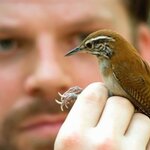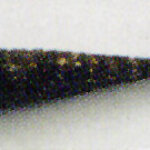Ecology & Zoology

If you can’t help but sing your heart out with your best friend when you hear Aladdin's A Whole New World or Johnny Cash and June Carter’s Jackson, maybe you can learn a thing or two about duets from birds.
Vocal duets in the animal kingdom have long been known to occur in animals like birds, primates, and whales. But despite much research, the answer to why animals duet has been elusive and controversial. Research by Dr. Daniel Mennill, an Associate Professor at the University of Windsor in Ontario, is helping to change that with some pretty technical equipment, one duet at a time.…

Bumblebees learn to avoid camouflaged predators by sacrificing foraging speed for predator detection, according to scientists from Queen Mary, University of London.
One of the bumblebee's main predators is the crab spider. Crab spiders hunt pollinating insects like bees and butterflies by lying in wait on flowers, and are particularly difficult for their prey to spot because they can change their colour to blend in with their surroundings.
Dr Tom Ings and Professor Lars Chittka from Queen Mary's School of Biological and Chemical Sciences wanted to discover whether bumblebees could learn to…

When asked if he felt bad killing the hundreds of oysters he serves daily at the popular Brophy Brothers Seafood Restaurant in Santa Barbara 28 year-old Andy Vogel, an employee for ten years, said the thought hadn't crossed his mind.
Oysters are not just something made into a shooter and served at a bar. Scientifically they can change sexes multiple times during their life, historically they have been consumed since prehistoric times, commercially they produce a tiny and valuable thing called a pearl and nutritionally they are one of the healthiest foods around.
In the beginning of his career…

Researchers report the discovery of the first new living species of giant clam in two decades, according to a report in Current Biology. While fossil evidence reveals that the new species, called Tridacna costata, once accounted for more than 80 percent of giant clams in the Red Sea, it now represents less than one percent of giant clams living there.
The researchers said they cannot say for sure which factors contributed to the loss of this giant clam species in favor of others, but the overall decline in giant clam stocks and the striking loss of large specimens is a "smoking gun" for…

If you live in Melbourne, Australia or even Sydney and are concerned that climate change will make your great cities ripe for a cane toad invasion, fear no more.
Yes, that is one of the many doomsday scenarios out there about climate change, but according to research recently published in Ecography by Dr Michael Kearney from the University of Melbourne and collaborators from Australia and the USA, the cane toad’s march will grind to a halt once it is physically too cold for the toads to hop.
Don't be too disappointed. There is still a chance that the LHC will doom the world, likely in…

Shedding some genetically induced excess baggage may have helped the tiny Indostomus paradoxus fish thrive in freshwater and outsize its marine ancestors, according to a University of British Columbia study published in Science Express.
Measuring three to 10 centimetres long, stickleback fish originated in the ocean but began populating freshwater lakes and streams following the last ice age. Over the past 20,000 years - a relatively short time span in evolutionary terms - freshwater sticklebacks have lost their bony lateral plates, or "armour," in these new environments.
"Scientists have…

There are no lost cities containing aliens and otherworldly technology but ancient settlements in the Amazon, now almost entirely obscured by tropical forest, were once large and complex enough to be considered "urban" as the term is commonly applied to both medieval European and ancient Greek communities, according to a paper in Science authored by anthropologists from the University of Florida and Brazil, and a member of the Kuikuro, an indigenous Amazonian people who are the descendants of the settlements' original inhabitants.
The paper also argues that the size and scale of the…

Are male Jamaican anole lizards masking some deep insecurity? Overcompensating for small body parts?
Nothing quite that dramatic, though the reason they begin and end the day with displays of reptilian strength, like push-ups, head bobs and extensions of a colorful neck flap, or dewlap, was unknown until recently.
The answer? Nothing more than wanting to defend their territory, according to a new study.
"Anoles are highly visual species, so in that sense it is not surprising that they would use visual displays to mark territory," said Terry J. Ord, a postdoctoral researcher at UC Davis and…

Five years ago, Edith had a problem: Her goldfish of 25 years, Mr. Fish, had dropsy, a disease characterized by a swollen or hollow abdomen and in most cases fatal. In her last attempt to save her pet, on a whim, Edith wrote a message on GoldfishConnection asking for help.
Rick G. Copeland, the specialist at the goldfish site, recommended some Medi-Gold pellets. Two years later, at age 27, Mr. Fish swam around his tank as if his close call with death never happened.
Mr. Fish may not have the 49 year-old record of the oldest goldfish ever, but he's working on it. In the meantime, Mr. Fish is…
Researchers from the University of Hawaii, the Wildlife Conservation Society, Smithsonian Tropical Research Institute, National Marine Fisheries Service and Projecto Meros do Brazil discovered a new species of fish; a grouper that reaches more than six feet in length and can weigh nearly 1,000 pounds. This newly discovered species can be found roaming the tropical reefs of the Eastern Pacific Ocean.
Was the massive fish hiding among the corals and sea grass to evade marine biologists? No, it was just a case of mistaken identity, as explained in a recent genetic study in the journal…